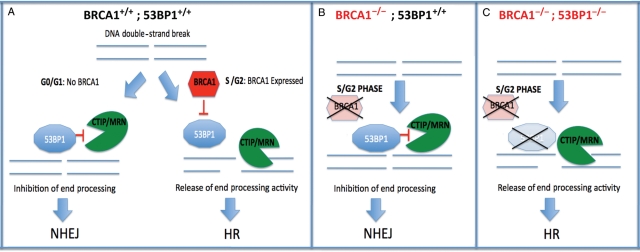Figure 2.
Collaboration of BRCA1 loss and 53BP1 loss results in synthetic viability and restoration of HR-mediated repair. (A) Normal cells: in G0/G1 there is no BRCA1 expression, and 53BP1 is recruited to DNA double-strand breaks (DSBs) where it restrains CtIP activity, inhibits end processing and promotes NHEJ. In S/G2 phases of the cell cycle, BRCA1 is normally expressed and recruited to sites of breaks, where it inhibits the action of 53BP1 on CtIP, allowing end processing and promoting HR mediated repair. (B) BRCA1−/− cells: BRCA1 is not present in S-phase, and 53BP1 remains free to inhibit CtIP function, leading to impaired end processing of breaks, suppression of HR and promotion of error-prone NHEJ. (C) BRCA1−/−; 53BP1−/− cells: during S-phase CtIP is recruited to sites of DNA breaks. In the absence of 53BP1, its activity is unrestrained allowing end processing and HR mediated repair.

